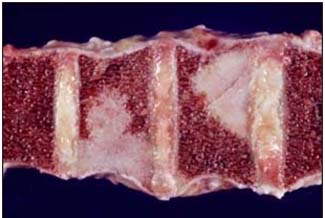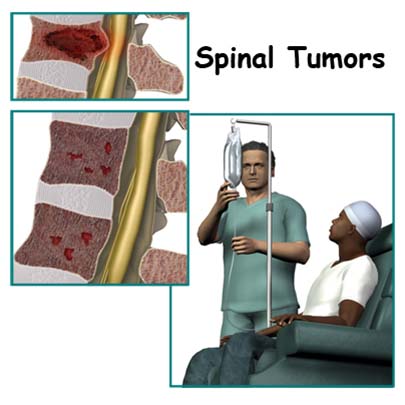Spinal Tumors India offers information on Spinal Tumors in India, Spinal Tumors cost India, Spinal Tumors hospital in India, Delhi, Mumbai, Chennai, Hyderabad & Bangalore, Spinal Tumors Surgeon in India
What is Spinal Tumors?
Anatomy of Spinal Tumors
Causes of Spinal Tumors
Symptoms of Spinal Tumors
Diagnosis of Spinal Tumors
Treatments for Spinal Tumors
What is Spinal Tumors?
A Spinal tumor – a cancerous or noncancerous growth that develops with the cervical (neck), thoracic (midback) or lumbosacral (lowback) regions or near the spinal cord or bones of the spine. They may be primary originating from the spinal cord or metastatic originating elsewhere (eg: lung, breast etc)

Anatomy of Spinal Tumors
The spine is composed of individual bones (vertebrae) stacked one on top of the other in a column. Each vertebra possesses a cylindrical body, which participates in weight bearing and an arch of bone (laminae and spinous processes) which protects the spinal cord and its coverings. The bony arch is connected to the body by two small columns of bone (pedicles). The circular canal between the body, arch, and pedicles houses the spinal cord and is called the spinal canal. The spinal cord is contained within the spinal canal and is covered by a layer of connective tissue, the dura mater. Tumors which are located outside the dura are called extradural. These are usually metastatic tumors and most often arise in the vertebrae themselves. Tumors arising inside the dura, but outside the actual substance of the spinal cord are termed intradural-extramedullary. These are usually nerve sheath tumors or meningiomas. Tumors arising within the substance of the spinal cord itself are called intramedullary tumors. These are usually astrocytomas or ependymomas. Different types of tumors often behave differently and require different treatments.
 Causes of Spinal Tumors
Causes of Spinal Tumors
Primary spinal cord tumors may be extramedullary (occurring outside the spinal cord) or Intramedullary (occurring within the cord itself).
Extramedullary tumors may be intradural (meningiomas and schwannomas) which account for 60% of all primary spinal cord neoplasms or extradural (metastatic tumors like from breasts, lungs, prostate, leukemia or lymphomas) which account for 25% of these neoplasms.
Intramedullary tumors or gliomas (astrocytomas or ependymomas) are comparatively rare accounting for only about 10% of tumors.
Spinal tumors are rare compared with intracranial tumors (ratio 1:4): They occur with equal frequency in men and women with the exception of meningiomas which occur most often in women. Spinal cord tumors can occur anywhere along the length of cord or its roots
Symptoms of Spinal Tumors
- Neck and back pain are common presenting symptoms of spinal cord tumors.
- The pain is often present at night and is worsened with physical activity.
- Loss of sensation or weakness especially in legs.
- Difficulty in walking sometimes leading to falls.
- Decreased sensitivity to pain, heat and cold.
- Loss of bowel and bladder function.
- Paralysis that may occur in varying degrees and n different parts of body depending on which nerves are compressed.
Diagnosis of Spinal Tumors
- Diagnosis of spinal tumors begins with history and physical examination
- Plain X-Rays
- Spinal Magnetic Resonance Imaging (MRI)
- CT Scan
- Myelogram
- Biopsy- whether the tumor is benign or malignant
Treatments for Spinal Tumors
Nonsurgical Treatment
DRUGS-because surgery and radiation therapy as well as tumors themselves can cause inflammation inside the spinal cord, doctors sometimes prescribe corticosteroids to reduce swelling either following surgery or during treatment.
Surgical Treatment of Spinal Tumors
Surgical options for the treated of spine tumors vary from complete to partial removal.
Surgical stabilization of the spine may be necessary as a result of instability caused by tumor itself or the surgery to remove it. This may be done by surgery approach from the front or back of spine. This may involve going through the neck, chest or abdomen. Newer techniques and instruments allows that were once inaccessible. The high powered microscopes used in microsurgery for instance make it easier to distinguish tumors from healthy tissue. The typical hospital stays after surgery to remove a spinal tumors range from approximately 5 to 10days
Radition therapy : This therapy is used following an operation to eliminate the remnant of tumors that cant be completely removed or to treat inoperable tumors.
Spinal Tumors India, Spinal Tumor, Spinal Tumor Symptom, India Hospital Tour, Spinal Cord Tumor Symptom, Spine Cancer, Tumor,Spinal Tumors Surgery, Spinal Tumors, Spinal Tumors India, Spinal Cord Tumor Surgery, Spinal, Spinal Cord Tumors, Spinal Tumors Surgery Removal India, Spinal Tumors Treatment India, Spinal Surgery Treatment India, Patient Experience India, Spinal Tumors Removal Treatment India, Low Cost Spinal Tumors Surgery India, Types Of Tumor India, Spinal Tumors Surgery Hospitals India





